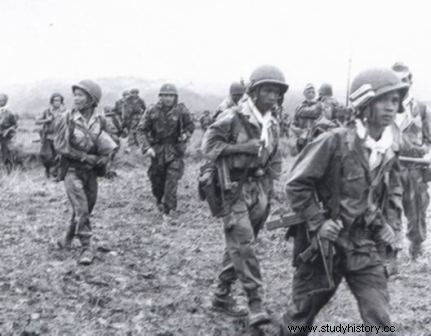
Once again, the surprise paid off. It was very hot, and the enemy units weren't guarding. The Companies. local and provincial fled, and only the depot guard detachment put up any resistance until air support was brought in. During the battle for the depots, the Viet Minh lost 5 prisoners and 21 confirmed killed.
When the battle was over, the French were able to identify their spoils. The depots contained 250 shelters, each containing 4 new Czech automatic rifles, 4 American G.M.C. and two Soviet Molotova trucks, 18,000 liters of gasoline, about 600 m3 of spare parts for engines, 250 tires, about 800 kilos of ammunition, 250 rifles and 50 submachine guns, 15 electric motors, 8 large machine tools, about 50 m3 of pieces of military clothing, 5,600 kilos of tea, telephone sets, typewriters, 20,000 pairs of shoes, documents and 500 cases of Russian cigarettes.
The count made , the destruction teams set to work; about 800 kilos of explosives were used, and by 4:00 p.m. the destruction of shelters, depots as well as parachutes by explosives or by fire was completely finished. The roads leading south and west were mined, and the two Bns. of Lang Son set out to join the elements of Loc Binh. The crossing of the river had been prepared and the operation covered on the flank facing the Chinese border. The forced march was a severe ordeal. The problems raised by the intense heat and fatigue were further aggravated by the presence of 300 civilians, men, women and children who had decided to accompany the French. They marched with the paratroopers for 48 hours without stopping and endured all the suffering of this painful journey.
On the 18th at around 11:00 p.m. Dinh Lap. The Gn. quickly prepared the road and, as the paratroopers took their places in the trucks, the first Coies. Viet Minh went on the attack. The Vietnamese opened machine gun fire, but the distance was too great. The paratroopers were transported by sea from Tien Yen to Haiphong and from there to Hanoi. Of the 2,001 men who had taken part in the raid, one had been killed, one missing and three others had died of exhaustion during the march; 21 casualties were evacuated by helicopter.
Phu Doan and Lang Son illustrated what could be achieved with flexible, well-trained airborne troops. The French carried out a large number of similar raids inside enemy territory:they were risky operations, but inexpensive and produced very good results. During routine patrols and smaller actions, Bns. Para had lost in 1953, 5,000 men killed, wounded or missing, that is to say more than 20 percent of their strength. Previously, General Jean de Lattre de Tassigny had put an end to enemy attacks in the Red River delta, thanks to the enormous firepower available to the French forces - the Viet-minh who had chosen to carry out conventional operations had been held in check in 1951. To General René Cogny, Commander-in-Chief in Tonkin, as to General Henri Navarre, his counterpart in Indochina, the lesson seemed clear:they had to stop the Viêt-minh offensive in Laos by setting a trap for the help of their airborne troops. We would establish behind the Vietminh, across his communications, a base that he would be forced to attack. Once he had concentrated his forces and ceased to operate in small, elusive units, he could be overwhelmed by the firepower of the French. All enemy reinforcements and supplies could be attacked on the move by the air force, while the French artillery would reject attacks directed against the base. During the Second World War, General-Major Orde Wingate had demonstrated, during the second Chindit operation in Burma, that his strongpoints were capable not only of resisting Japanese attacks, but also of disrupting enemy lines of communication. and severely affect their offensive ability like in Kohima and Imphal. These strongpoints depended entirely on air supply, but that being so, they were capable of pinning down large enemy forces and destroying them. It was this idea that determined the French to set up a base at Diên Biên Phû.
Diên Biên Phû was a small village located at a crossing point of the Nam Yum River. There were the remains of an airfield built by the Japanese during the Second World War, and the bottom of the valley bristled with a number of small hills which were considered favorable for the establishment of defensive positions. The site was, however, 225 km from the French airfields in Hanoi, but was only 130 km from the Chinese border. The valley is 16 km long by just over 6 km wide and is flanked by hills ranging in altitude from 425 to 550 meters. During the preparation of the operation, certain elements were overlooked which were to have serious consequences - the valley was subject to flooding during the monsoon season and thick fogs, accompanied by rain, were likely to strongly hinder the approach in flight — in addition, the authors of the project had completely neglected the possibility of an entry into action of the AA artillery of the Viet Minh.
The rough volcanic mountain, 170 meters high, steeply sloping to the sea side, was not of vital importance for the defense of Iwo Jima. However, it offered beautiful observation and firing sites for the artillery:on the other hand. because of its imposing appearance. Mount Suribachi symbolized, for
